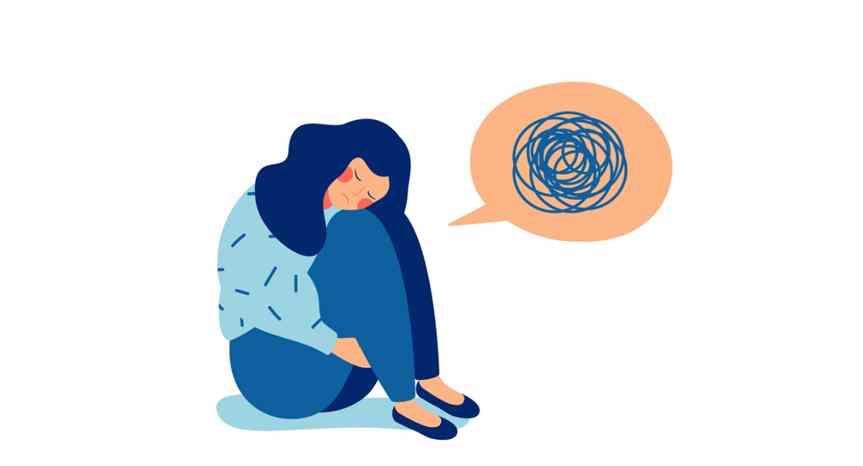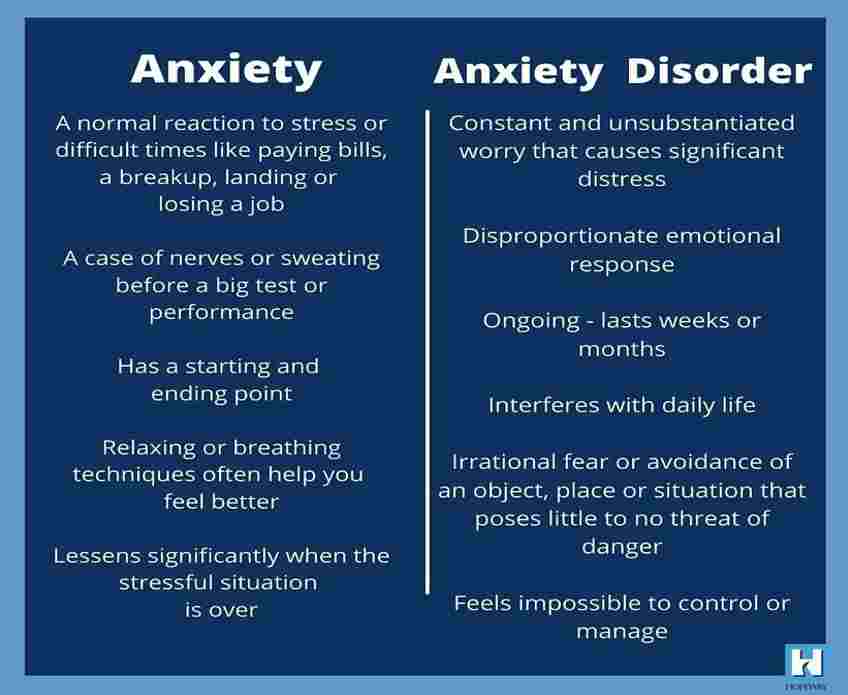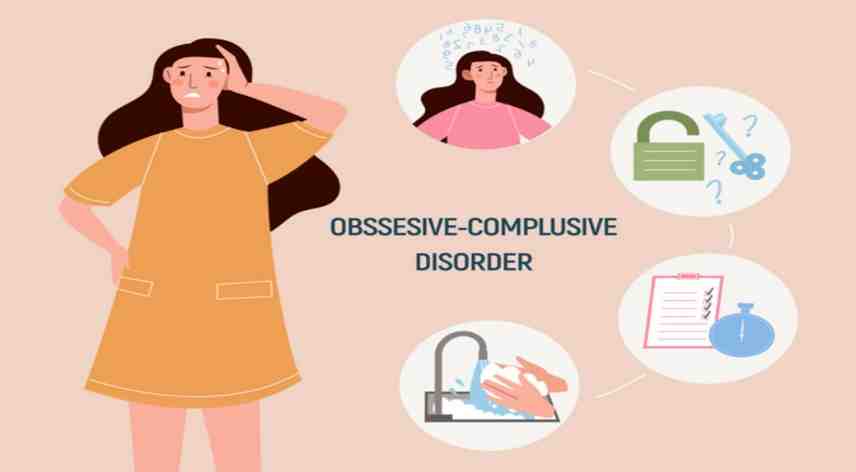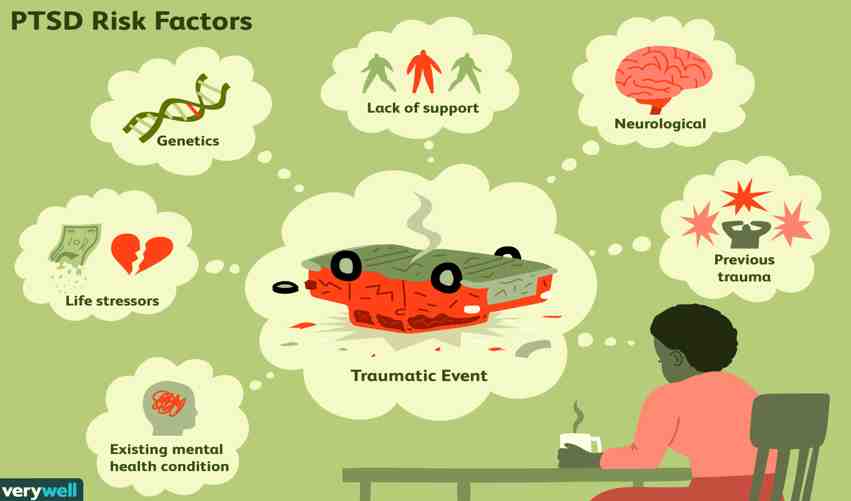- Umang Sagar
- Psychology, Recent article
Anxiety Disorders

Introduction
- We have all experienced anxiety, the state of tension and apprehension that is a natural response to a perceived threat. But not all of us have suffered from anxiety disorders. So, what makes anxiety disorders different from the anxiety we normally experience? In anxiety disorders, the frequency and intensity of anxiety responses are out of proportion to the situations that trigger them, and the anxiety starts interfering with daily life.
What Is Anxiety?

An anxiety disorder occurs when:-
- Anxiety impairs your ability to function.
- When something triggers your emotions, you frequently overreact.
- You have no control over your reactions to situations.
Anxiety disorders can manifest themselves in various ways, each of which is more common in women than in men. Anxiety disorders significantly interfere with life functions in more than 70% of cases and cause the person to seek medical or psychological treatment.
Anxiety responses are made up of four parts:-
A subjective-emotional component, such as feelings of tension and apprehension;
A cognitive component, such as troubling thoughts and a sense of helplessness;
Physiological responses, such as increased heart rate and Blood Pressure, Muscle Tension, Rapid Breathing, Nausea, Dry mouth, Diarrhoea, Frequent Urination; and
- Behavioural responses, such as avoidance of certain situations and impaired task performance.
- Anxiety disorders can be classified as phobic disorders, generalized anxiety disorders, panic disorders, obsessive-compulsive disorders, or posttraumatic stress disorders.
Types Of Anxiety And Their Symptoms
1. Phobic Disorder:-

Phobias are intense, irrational fears of specific objects or situations. Phobos, the Greek god of fear, whose image was painted on masks and shields to frighten enemies in battle, inspired the term phobia. People who have phobias are aware that their fears are out of proportion to the danger, but they feel powerless to deal with them. They instead make concerted efforts to avoid the phobic situation or object.
Agoraphobia, a fear of open or public places from which escape is difficult, is one of the most common phobias in Western society.
Social phobias are an excessive fear of being evaluated and possibly embarrassed in social situations.
Fears of dogs, snakes, spiders, aeroplanes, elevators, enclosed spaces, water, injections, or germs are examples of specific phobias. Fear of animals is common in women, while fear of heights is common in men.
Phobias can appear at any age, but they are most common in childhood. Many social phobias develop as a result of extreme shyness as a child. Phobias can develop during adolescence or early adulthood. Phobias rarely go away on their own, and they may broaden and intensify over time. The degree of impairment caused by a phobia is determined in part by how frequently the phobic stimulus is encountered in the individual’s normal activities. Fear of flying, for example, is a common phobia that affects approximately 25 million Americans. An aeroplane phobia may be a minor inconvenience for someone who never needs to fly, but it would be a significant handicap for a sales representative whose job requires extensive travel. Some people, on the other hand, are able to develop job-saving strategies in order to keep their anxiety under control.
2. Generalized Anxiety Disorder:-

- Generalized anxiety disorder, as the name implies, is a chronic (ongoing) state of diffuse, or free-floating, anxiety that is not attached to specific situations or objects. The anxiety can last for months, with the symptoms almost always present. As one might expect, this disorder can significantly impair daily functioning, even if the symptoms do not persist for the 6 months required for a formal diagnosis. The individual may struggle to concentrate, make decisions, and remember commitments. Onset typically occurs during childhood and adolescence.
3. Panic Disorder:-

Panic disorders, as opposed to generalized anxiety disorder, which involves chronic tension and anxiety, occur suddenly and unexpectedly, and they are much more intense. Panic attack symptoms can be terrifying. It is not uncommon for victims to believe they are dying; panic attacks usually occur unexpectedly and in the absence of any discernible stimulus. This unpredictability is what makes panic attacks so mysterious and frightening to their victims. Around 60% of people who have daytime panic disorders also have nighttime panic attacks. Their symptoms cause them to become aware that they are dying. Many people who have recurrent panic attacks develop agoraphobia (aversion to public places) because they are afraid of having another attack.
Recurrent attacks that do not appear to be related to environmental stimuli, followed by psychological or behavioral problems, are required for a formal diagnosis of panic disorder. These are typically characterized by a persistent fear of future attacks or agoraphobic responses. Panic disorders, whether with or without agoraphobia, typically appear in late adolescence or early adulthood, affecting approximately 6% of the population over their lifetime. Panic attacks are becoming more common. According to one survey of Canadian students, 34% had at least one unexpected panic attack in the previous year, usually during times of extreme stress.
4. Obsessive Compulsive Disorder:-

Such disorders typically have two components, one cognitive and one behavioural, though either can occur alone. Obsessions are unwanted and repetitive thoughts, images, or impulses that enter consciousness, are often repulsive to the person, and are difficult to dismiss or control. Contamination-related thoughts and images ruled over this mother. Compulsions are habitual behavioural responses, such as cleaning rituals, that can only be overcome with great difficulty. Compulsions are frequently used to alleviate the anxiety caused by intrusive thoughts.
Louis Pasteur’s discovery of a process for eliminating harmful microorganisms and limiting fermentation in milk, beer, and other liquids resulted from one man’s obsession. His never-ending work on this invention was fueled in part by his own preoccupation with contamination and infection. Pasteur refused to shake others’ hands and had a habit of vigorously wiping his plate and glass before eating. Controlling behavioural compulsions is extremely difficult. They frequently involve repeatedly checking things (for example, whether the door was locked or the gas burners on the stove were turned off), cleaning or hand washing, and endlessly repeating tasks. If the compulsive act is not performed, the person may experience intense anxiety, possibly even a panic attack. Compulsions, like phobic avoidance responses, are reinforced through a negative reinforcement process because they allow the person to avoid anxiety. According to recent research, the lifetime prevalence of the obsessive-compulsive disorder in the United States is approximately 1.6 per 100 people. Onset usually happens in your twenties.
5. Post Traumatic Disorder:-

- Posttraumatic stress disorder (PTSD) is a severe anxiety disorder that can develop in people who have experienced traumatic events in their lives. This anxiety disorder is characterized by four major symptoms:-
- The person experiences severe anxiety, arousal, and distress symptoms that were not present prior to the trauma.
- The victim relives the trauma in flashbacks, dreams, and fantasy on a regular basis.
- The person loses touch with reality and avoids stimuli that remind them of the trauma.
- The individual feels intense survivor guilt when others are killed and the individual is somehow spared.
The PTSD category arose in part from studies of soldiers who had witnessed war horrors. According to one study, Vietnam veterans who spent significant time in combat and were wounded were seven times more likely to develop PTSD than other Vietnam-era veterans (Centres for Disease Control [CDC], 1988). Another study found a 12-month PTSD rate of 27.8 percent after combat exposure. Civilian war victims may be at greater risk than soldiers. Amy Ai and colleagues (2002) discovered a PTSD rate of 60.5 percent in a sample of refugees from Kosovo’s bloody civil war. On average, the refugees reported 15 traumatic events related to the war. Human-caused traumas, such as war, rape, and torture, are 5 to 10 times more likely to result in PTSD than natural disasters like hurricanes and earthquakes. Women have twice the rate of PTSD as men after experiencing traumatic events.
Terrorist acts can have a significant impact on PTSD. In the 5 to 8 weeks following the September 11, 2001 attacks, 7.5 percent of 1,008 adult Manhattan residents reported symptoms consistent with a PTSD diagnosis. The PTSD rate was 20% among those who lived closest to the World Trade Centre. The psychological damage caused by PTSD may increase vulnerability to the development of other disorders later in life. According to one study, women who had PTSD were twice as likely to develop a depressive disorder and three times more likely to develop alcohol-related problems in the future. A meta-analysis of 39 studies found that trauma exposure resulted in significant increases in anger, hostility, and aggression. These findings emphasize the significance of post-traumatic intervention aimed at preventing the development of PTSD.
Possible Causes Of Anxiety
- Anxiety is a complex phenomenon with biological, psychological, and environmental causes, and research at all three levels has provided significant insights into the development and maintenance of anxiety disorders. Any of these factors, according to the vulnerability-stress model presented earlier, can create predispositions to respond to stressors with an anxiety disorder.
1. Biological Factors:-

Although such findings suggest a genetic predisposition, concordance rates are far from 100 percent, indicating the importance of psychological and environmental factors. According to psychologist David Barlow (2002), a leading expert on anxiety disorders, the genetically caused vulnerability may manifest as an autonomic nervous system that overreacts to a perceived threat, resulting in high levels of physiological arousal.
Overactivity of neurotransmitter systems involved in emotional responses may also be caused by hereditary factors. Some researchers believe that abnormally low levels of inhibitory GABA activity in these arousal areas may cause some people to have highly reactive nervous systems that respond to stressors with anxiety. Brain scans show that patients with a history of panic attacks have a 22% lower concentration of GABA in the occipital cortex than age-matched controls without panic disorder, lending support to this hypothesis. Even after the researchers used statistical methods to control for sex differences in 11 psychosocial factors (including negative life events, self-esteem, and social support), there was still a significant sex difference in anxiety disorders. Such findings point to a sex-linked biological predisposition to anxiety disorders, but social conditions that give women less power and control may also play a role. As in other cases of sex differences, biological, psychological, and environmental factors appear to interact in complex ways.
2. Psychological Factors:-
Neurotic anxiety, according to Freud, occurs when unacceptable impulses threaten to overwhelm the ego’s defenses and explode into consciousness or action. According to Freud, neurotic anxiety in phobic disorders is displaced onto some external stimulus that has symbolic significance in relation to the underlying conflict. In one of Freud’s most famous cases, a 5-year-old boy named Hans developed a sudden fear of horses and the possibility of being bitten. The obsession, according to Freud, is symbolically related to, but less terrifying than, the underlying impulse. Finally, generalized anxiety and panic attacks are thought to occur when one’s defenses are insufficient to control or contain neurotic anxiety but are sufficient to conceal the underlying conflict.
Factors of cognition: the role of maladaptive thought patterns and beliefs in anxiety disorders is emphasized by cognitive theorists. Cognitive processes are also important in panic disorders. Panic attacks, according to David Barlow (2002), can be triggered by exaggerated misinterpretations of normal anxiety symptoms such as heart palpitations, dizziness, and shortness of breath. The person interprets these as warning signs of a heart attack or a psychological breakdown, and these catastrophic interpretations increase anxiety until the process spirals out of control, resulting in a full-fledged state of panic. Helping panic patients replace such dire assessments with more benign interpretations of their bodily symptoms (e.g., “It’s just a little anxiety, not a heart attack”) results in a significant reduction in panic attacks.
The Importance of Education Classical conditioning, observational learning, and operant conditioning can all contribute to the development of an anxiety disorder. Some fears develop as a result of traumatic experiences that elicit a classically conditioned fear response. A person who has suffered a traumatic fall from a high place, for example, may develop a fear of heights (CR) because the high place (CS) was associated with the fall’s pain and trauma (UCS). However, classical conditioning cannot explain everything because many phobic people have never had a traumatic experience with the phobic object or situation they now fear. However, most people do not develop phobias under these conditions, implying that there is something else going on. It’s possible that biological and cognitive factors influence whether a person develops a phobia after witnessing or hearing about a traumatic event. Thus, if a person has a biological proclivity for intense fear, witnesses traumatic scenes, and comes to believe that “the same thing could happen to me,” the likelihood of developing a phobia based on observational learning may increase. Once anxiety has been learned, whether, through classical or vicarious conditioning, it can be triggered by external cues or internal cues such as thoughts and images. Anxiety-inducing cues in panic disorders tend to be internal, such as bodily sensations (e.g., heart palpitations) or mental images, such as the image of collapsing and having a seizure in public. Operant conditioning, in addition to classical conditioning and observational learning, plays a role. In the case of agoraphobia, staying at home serves as a safety signal, indicating that the person is unlikely to have a panic attack. It keeps the learned anxiety response from being extinguished, which would happen if these people were exposed to the feared stimuli repeatedly without experiencing the feared consequences.
3. Sociocultural Factors:-

- Anxiety disorders are also influenced by social and cultural factors. The role of culture is most evident in culture-bound disorders, which occur only in specific locations. Taijin Kyofushu, a social phobia, is one such disorder found in Japan. Koro, a Southeast Asian anxiety disorder in which a man fears that his penis will retract into his abdomen and kill him, is another culture-bound disorder. This eating disorder is almost entirely found in developed countries where thinness has become a cultural obsession.
Diagnosis And Treatment

1. A Mental Health Provider May:-
Perform a psychological evaluation to aid in the diagnosis of an anxiety disorder. This entails discussing thoughts, feelings, and behavior in order to narrow down a diagnosis and rule out any potential complications. Anxiety disorders frequently coexist with other mental health issues, such as depression or substance abuse, making diagnosis more difficult.
Compare your symptoms to the DSM-5 criteria. Many doctors use the criteria in the American Psychiatric Association’s Diagnostic and Statistical Manual of Mental Disorders (DSM-5) to diagnose anxiety disorders.
2. Psychotherapy:-

Psychotherapy, also known as talk therapy or psychological counselling, entails working with a therapist to reduce your anxiety symptoms. It has the potential to be an effective anxiety treatment.
The most effective type of psychotherapy for anxiety disorders is cognitive behavioral therapy (CBT). CBT, in general, is a short-term treatment that focuses on teaching the client specific skills to improve symptoms and gradually return the client to the activities they are avoiding due to anxiety.
CBT includes exposure therapy, in which the client is gradually exposed to the object or situation that causes their anxiety so that they can gain confidence and manage the situation and anxiety symptoms.
3. Medications:-

- Depending on the type of anxiety disorder you have and whether you also have other mental or physical health issues, different medications are used to help relieve symptoms. As an example: anxiety disorders are also treated with antidepressants. Buspirone, an anti-anxiety medication, may be prescribed.
Top 13 Interesting Facts About Anxiety Disorders
Anxiety disorders differ from normal feelings of nervousness or anxiety in that they involve excessive fear or anxiety and typically result in reactions that are out of proportion to the situation.
Specific and social phobias are the most common anxiety disorders.
Panic disorder is associated with the highest levels of anxiety.
Women are more likely than men to suffer from anxiety disorders.
Negative-reinforcement processes can explain some aspects of agoraphobia.
Anxiety disorders may be predisposed to genetic factors.
Anxiety is a cause of, or a trigger for, depression.
Physical symptoms of anxiety include restlessness, irritability, and a lack of concentration.
Exercise can help alleviate anxiety.
Generalized anxiety disorder is frequently diagnosed in childhood.
Many people who have an anxiety disorder also have another disorder or a physical illness, which can exacerbate their symptoms and make recovery more difficult.
Anxiety disorders are treatable, and professional care can help the vast majority of people with anxiety disorders.
Despite the fact that anxiety disorders are highly treatable, only about one-third of those who suffer from them receive adequate treatment or counseling.


